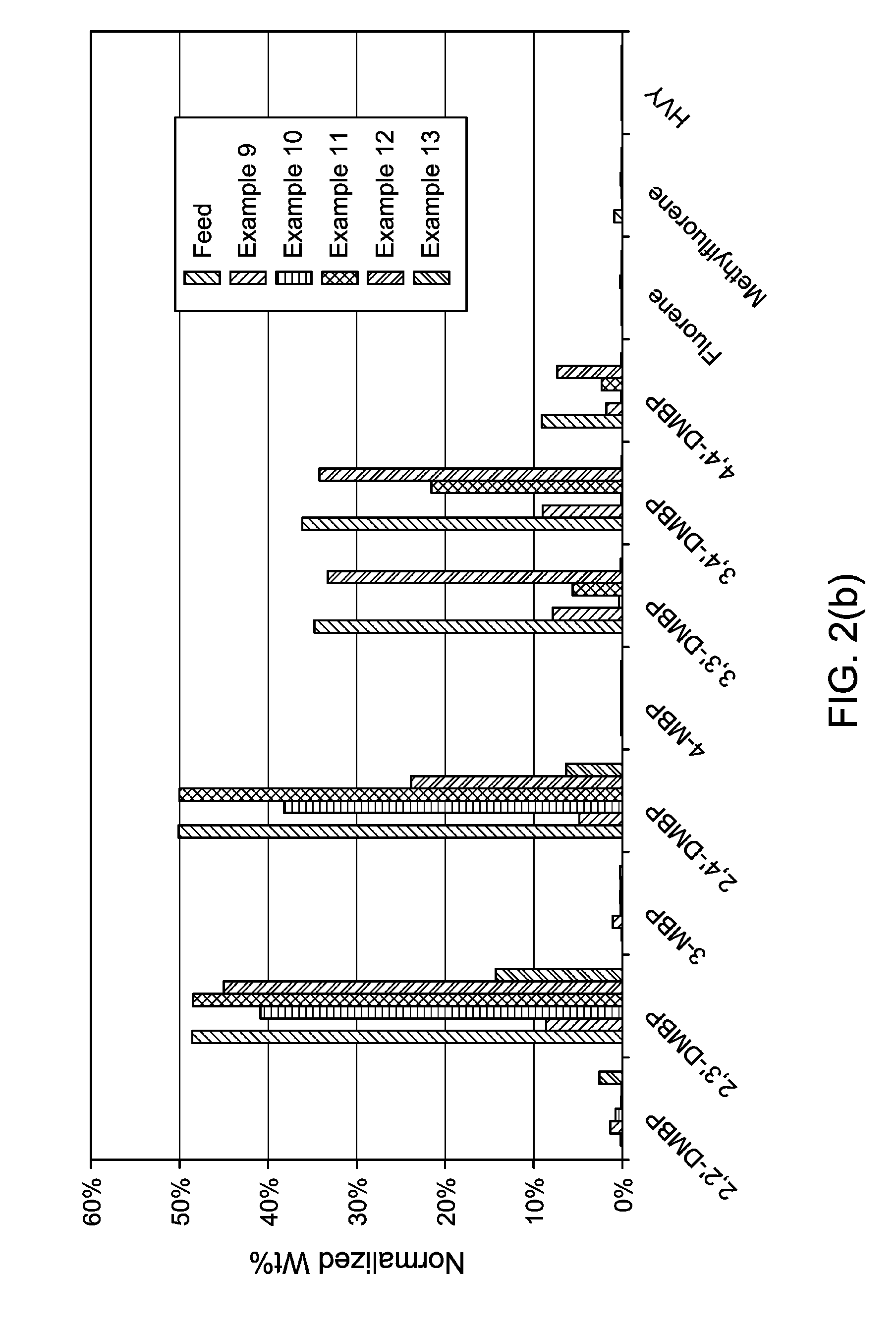Production and Use of Dialkylbiphenyl Isomer Mixtures
a technology of dialkylbiphenyl isomers and mixtures, which is applied in the direction of hydrocarbon preparation catalysts, hydrocarbon by addition and hydrogenation, organic chemistry, etc., can solve the problem that carbons tend to be too volatile for plasticizers, and achieve the effect of low conversion of unreacted mch
- Summary
- Abstract
- Description
- Claims
- Application Information
AI Technical Summary
Benefits of technology
Problems solved by technology
Method used
Image
Examples
examples 1 to 13
Study of Dimethylbiphenyl Isomerization in Batch Reactor
[0156]A study of 12 different catalysts for the isomerization of 2,X′ dimethylbiphenyl was conducted in a mini reactor in a furnace. The catalysts employed are shown in Table 2.
TABLE 2ExampleCatalyst165 wt % MCM-22, 35 wt % Al2O3280 wt % MCM-49, 20 wt % Al2O3380 wt % Beta, 20 wt % Al2O3460 wt % MCM-56, 40 wt % Al2O352.5 wt % Mg on 65 wt % TEA mordenite, 35 wt % Al2O36ZSM-12 crystal7MCM-49 crystal82.7 wt % Mo on MCM-49 crystal965 wt % TEA mordenite, 35 wt % Al2O31050 wt % ZSM-5, 50 wt % Al2O3111.8 wt % B2O3 on Al2O31265 wt % ZSM-12, 35 wt % SiO21380% USY, 20% Al2O3
[0157]The catalyst of Example 11 was prepared by incipient wetness impregnation of RT-225 Al2O3 extrudates with surface area of 306 m2 / g, pore volume of 0.85 cm3 / g, and pore size of 73 {acute over (Å)} with boric acid. For example, 1.6554 g of boric acid H3BO3 was dissolved in 25 g of water. The boric acid solution volume was adjusted to 43.2 ml with water, which was a...
examples 14 and 15
Study of Dimethylbiphenyl Isomerization in Fixed Bed Reactor
[0160]In these Examples, isomerization of 2,3′ and 2,4′ DMBP over the Al2O3 support of Example 11 (Example 14) and 80 wt % ZSM-5 (25:1 Si / Al2 [mol / mol]), 20 wt % Al2O3 catalyst (Example 15) were conducted in a continuous, fixed bed reactor.
[0161]These experiments utilized a reactor unit with 8 parallel reactors heated by furnace. For different tests anywhere from 1-8 reactors were utilized. The reactors used in these experiments consisted of quartz tubes of 9 mm in diameter. Annular N2 flow on the outside of the quartz reactor allowed for pressure equilibration between the inside and outside of each reactor channel. Catalyst extrudates were crushed to 20 / 40 mesh loaded in quantities ranging from 0.25-2 g (to vary corresponding weight based space velocity) after being diluted up to 4 g in crushed quartz. A quartz wool plug was used at the top and bottom of the catalyst bed to keep catalyst in place. Two sets of four parallel...
examples 16 to 21
Study of Dimethylbiphenyl Isomerization in Fixed Bed Reactor
[0165]In these experiments, the fixed bed reactor of Examples 14 and 15 was again employed, with 1 g of catalyst being loaded and liquid flow rates corresponding to a space velocity of 2 hr−1. The liquid feed was 2,4′ DMBP diluted in 90% toluene. A 0.5:1 molar co-feed of nitrogen was utilized and the reactor pressure was held between 175-180 psig. The catalysts listed in Table 3 were tested:
TABLE 3ExampleCatalyst1680 wt % ZSM-5 (25:1 Si / Al2), 20 wt % Al2O31780 wt % USY (60:1 Si / Al2), 20 wt % Al2O31880 wt % Beta, 20 wt % Al2O31980 wt % USY (30:1 Si / Al2), 20 wt % Al2O32065 wt % TEA mordenite (35:1 Si / Al2), 35 wt % Al2O32165 wt % TEA mordenite (19:1 Si / Al2), 35 wt % Al2O3
[0166]The catalysts of Examples 16, 18 and 20 were tested at 175° C. and 225° C. and the results are shown in FIGS. 4(a) and (b) respectively. The results show that the zeolite Beta catalyst was effective in the isomerization of 2,4′ DMBP at both temperatures ...
PUM
 Login to View More
Login to View More Abstract
Description
Claims
Application Information
 Login to View More
Login to View More - R&D
- Intellectual Property
- Life Sciences
- Materials
- Tech Scout
- Unparalleled Data Quality
- Higher Quality Content
- 60% Fewer Hallucinations
Browse by: Latest US Patents, China's latest patents, Technical Efficacy Thesaurus, Application Domain, Technology Topic, Popular Technical Reports.
© 2025 PatSnap. All rights reserved.Legal|Privacy policy|Modern Slavery Act Transparency Statement|Sitemap|About US| Contact US: help@patsnap.com



